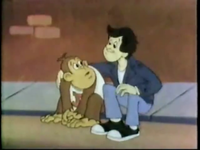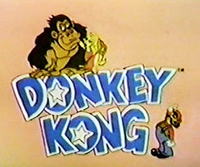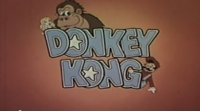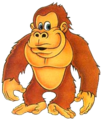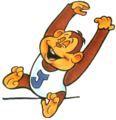Saturday Supercade: Difference between revisions
mNo edit summary |
No edit summary |
||
| Line 141: | Line 141: | ||
PaulineSupercadeArt.png|[[Pauline]] | PaulineSupercadeArt.png|[[Pauline]] | ||
</gallery> | </gallery> | ||
==Trivia== | |||
This marks the first appearance of Mario's modern color scheme in America; a red hat and shirt, and blue overalls. | |||
==External links== | ==External links== | ||
*[http://imdb.com/title/tt0085008/fullcredits Cast and Crew] - Full cast and crew on IMDB. | *[http://imdb.com/title/tt0085008/fullcredits Cast and Crew] - Full cast and crew on IMDB. | ||
Revision as of 01:24, March 14, 2024
| Saturday Supercade | |
|---|---|
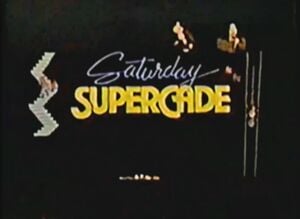
| |
| General information | |
| Format | Children's television series |
| Opening theme | "Supercade" |
| Country of origin | United States of America |
| Original language | English |
| Seasons | 2 |
| Episodes | 97 |
| Production | |
| Production company | Ruby-Spears Productions |
| Distributor(s) | CBS Broadcasting, Inc. |
| Runtime | 50 minutes |
| Broadcast | |
| Channel(s) | CBS |
| First aired | September 17, 1983[?] |
| Last aired | December 1, 1984[?] |
| Status | Ended |
Saturday Supercade is an animated television series based on several arcade games, including Donkey Kong, Donkey Kong Jr., Frogger, Q*bert, Pitfall!, Kangaroo, and Space Ace. Each episode is approximately one hour long and comprises four shorter, self-contained segments based on one arcade game each. The show originally aired on Saturday mornings on CBS Broadcasting Inc. television network beginning on September 17, 1983. After two seasons, the show's original run ended on December 1, 1984. Ruby-Spears Productions produced the series. While the Donkey Kong segments appeared in both seasons, the Donkey Kong Junior segments ended after the first season. In total there are nineteen Donkey Kong segments and thirteen Donkey Kong Junior segments.
Since the show's end, the Donkey Kong and Donkey Kong Junior segments have ceased to air on television. Additionally, the series has not been reproduced in any format, and as such only homemade recordings of the segments made during the show's television airing are available to the public. Music Corporation of America Inc., then-owner of Universal City Studios, was the last known holder of the segments (due to a deal made between MCA/Universal and Ruby-Spears in the leadup to Universal's lawsuit against Nintendo),[1][2] but it is unclear if Universal or related entities still have any rights to the segments. The copyright to the segments (excluding the Space Ace segments) was assigned to the owners of the source materials, including the Donkey Kong and Donkey Kong Junior segments; it appears that said segments are owned by Nintendo of America.[3] When questioned by a fan on Facebook, the Warner Archive Collection team stated that the accessible segments of the show may be released on DVD in 2011, with "cool vintage footage" replacing any unavailable segments,[4] but this did not come to fruition.
Predating Super Mario Bros.: Peach-hime Kyūshutsu Dai Sakusen! by nearly three years, Saturday Supercade marked the first animated adaption of any Super Mario-related series. A few months before the series aired, however, TV commercials for Donkey Kong cereal and the Game & Watch included animated Super Mario characters.[5][6][7] It also marked the first appearances of Mario and Donkey Kong in a television series, both of whom would later star in their own television series with The Super Mario Bros. Super Show! in 1989 and Donkey Kong Country in 1996 respectively. The show also marked the currently only televised appearances of the characters Pauline, Donkey Kong Jr., and Stanley, all from the Donkey Kong series.
Plot synopsis
Donkey Kong
Similar to the premise of Donkey Kong Circus, the introduction to the Donkey Kong segments show that Mario apparently owned the circus along with his animal trainer Pauline and the star of the show, Donkey Kong. However, the gorilla escaped and made his way down a dock on a motorcycle, pursued by Mario and Pauline in their circus van. Exiting the van, the pair gave chase on foot until Mario slipped on a banana peel laid by Donkey Kong as a trap. The tables turned, the pair fled from the approaching ape. However, Mario and Pauline quickly resumed pursuit with a net and followed him up the stairway of a building. Their resultant chase is outlined in the Donkey Kong segments.
Most stories had the trio happening on crime, with criminals usually involved in schemes involving theft, fraud, and deceit. Often, the crooks would realize Donkey Kong's slow-wittedness and try to get him to do their dirty work, but in the end, Donkey Kong would either realize the truth himself or Mario and/or Pauline would reveal the facts to the ape, and in the end, the bad guys' plot was foiled. The chase then continued.
Donkey Kong Junior
Outlined in the introduction to the Donkey Kong Junior segments, Donkey Kong Jr. traveled from the jungle to Mario's circus to see his father, Donkey Kong. Realizing that his dad has escaped and without means of finding him, Donkey Kong Jr. is reduced to tears. Bones approached Junior and consoled him. After hearing his story, Bones suggested they follow after Donkey Kong in his motorcycle. Overjoyed, Donkey Kong Jr. joyously yelled his catchphrase, "Monkey muscle!" and took the drivers seat. With Bones in the sidecar covering his eyes, the two sped off on the first of their adventures which are outlined in the Donkey Kong Junior segments.
Episodes
Donkey Kong
Season 1
- "Mississippi Madness"
- "Gorilla Gangster"
- "Banana Bikers"
- "The Incredible Shrinking Ape"
- "Movie Mania"
- "Gorilla My Dreams"
- "Little Orphan Apey"
- "Circus Daze"
- "The Great Ape Escape"
- "Apey and the Snowbeast"
- "How Much is That Gorilla in the Window?"
- "Private Donkey Kong"
- "Get Along, Little Apey"
Season 2
- "Sir Donkey Kong"
- "The Pale Whale"
- "El Donkey Kong"
- "New Wave Ape"
- "Greenhouse Gorilla"
- "Hairy Parent"
Donkey Kong Junior
- "Trucknapper Caper"
- "Sheep Rustle Hustle"
- "Rocky Mountain Monkey Business"
- "Magnificent Seven-Year Olds"
- "The Ventriloquist Caper"
- "The Great Seal Steal"
- "The Jungle Boy Ploy"
- "Junior Meets Kid Dynamo"
- "The Amazing Rollerskate Race"
- "A Christmas Story"
- "Gorilla Ghost"
- "The Teddy Bear Scare"
- "Double or Nothing"
Voices
- Bones - Bart Braverman
- Donkey Kong - Milton Supman
- Donkey Kong Jr. - Frank Welker
- Mario - Peter Cullen
- Pauline - Judy Strangis
Theme song
- "Supercade"
Well, Saturday Supercade, gather 'round,
We'll get your video friends together.
Yeah, Saturday Supercade, it's time for fun,
And no one else can do it better.
And it feels so right,
Because it's Supercade time!
Let's have some Supercade fun!
Yes, it's Supercade time,
Let's have some Supercade fun, fun, fun!
Come on, to Supercade time,
Join all the Supercade fun.
Yes, it's Supercade time,
Let's have some Supercade fun, fun, fun!
Come on, to Supercade time,
Join all the Supercade fun.
Monkey Muscle!
(Monkey Noises)
Let's have some Supercade fun.
(It's Saturday Supercade!)
Staff
- Main article: List of Saturday Supercade staff
Gallery
- For this subject's image gallery, see Gallery:Saturday Supercade.
Trivia
This marks the first appearance of Mario's modern color scheme in America; a red hat and shirt, and blue overalls.
External links
- Cast and Crew - Full cast and crew on IMDB.
References
- ^ Universal City Studios, Inc. v. Nintendo; United States District Court, S.D. New York; Jul 29, 1985; 615 F. Supp. 838 (S.D.N.Y. 1985)
- ^ Universal City Studios v. Nintendo Co.; United States District Court, S.D. New York; Dec 22, 1983; 578 F. Supp. 911 (S.D.N.Y. 1983)
- ^ Copyright listing for Saturday Supercade : no. 1, copyright registration number PA0000222759
- ^ Saturday Supercade - Could the '80s Coin-Op-Based Cartoons be Coming Home? Warner Says... (Archived)
- ^ William Marshall Donkey Kong Commercial (1983).YouTube. Retrieved December 25, 2021.
- ^ Nintendo Game And Watch (Commercial, 1983). YouTube. Retrieved December 25, 2021.
- ^ Nintendo - Mario's Cement Factory Video Game Commercial - 1983. YouTube. Retrieved May 13, 2022.
